Stop Richmond Root Wars: Prevent Crowding on Clay Soil
Fighting underground battles in your garden? Heavy clay soil can lead to root crowding, stressing your plants. Ready for peaceful growth?
Quick Guide to Preventing Root Crowding:
- Understand Ottawa's heavy clay soil challenges (compaction, poor drainage).
- Avoid planting too closely – check mature plant sizes!
- Amend soil broadly with organic matter (compost) to improve structure.
- Plant at the correct depth (root flare visible).
- Use mulch to conserve moisture and regulate soil temperature.
- Water deeply and infrequently.
Introduction: Calling a Truce in Your Richmond Garden's Underground Battles
Hey Richmond gardeners! Ever get the feeling there's a secret battle raging beneath your beautiful flower beds? While things look serene above ground, down below, your plant roots might be waging a serious turf war. This underground skirmish, known as root crowding, is a common headache, especially for those of us gardening in the Ottawa region's notoriously heavy clay soil. Think of it like trying to find elbow room at a popular event – space gets tight down there!
When roots get too crowded, they compete fiercely for water and nutrients. This often leads to stressed, unhappy plants and landscaping that just doesn’t perform its best. You might see stunted growth, yellowing leaves, or plants that just seem *blah*, no matter how much you fuss over them above ground. It’s like a hidden struggle happening right under your feet, impacting everything from your prized perennials to your favourite shrubs.
But fear not! It's time to call a truce in this subterranean conflict. In this guide, we'll dig into *why* this underground crowding happens (spoiler: our lovely clay soil plays a big part!), how to spot the tell-tale signs in your own garden, and most importantly, share practical tips and landscaping strategies to give your plant roots the breathing room they desperately need to thrive. Let's bring peace, harmony, and healthier growth to your Richmond garden's underworld!
Getting Your Boots Dirty: Understanding Ottawa's Clay Soil Challenge
Okay, let's roll up our sleeves and get acquainted with the ground beneath our feet here in Ottawa. If you've ever felt like you need a jackhammer just to plant a petunia, especially if you're gardening in areas like Barrhaven or Nepean, chances are you've already had a *very* close encounter with our region's famous clay soil.
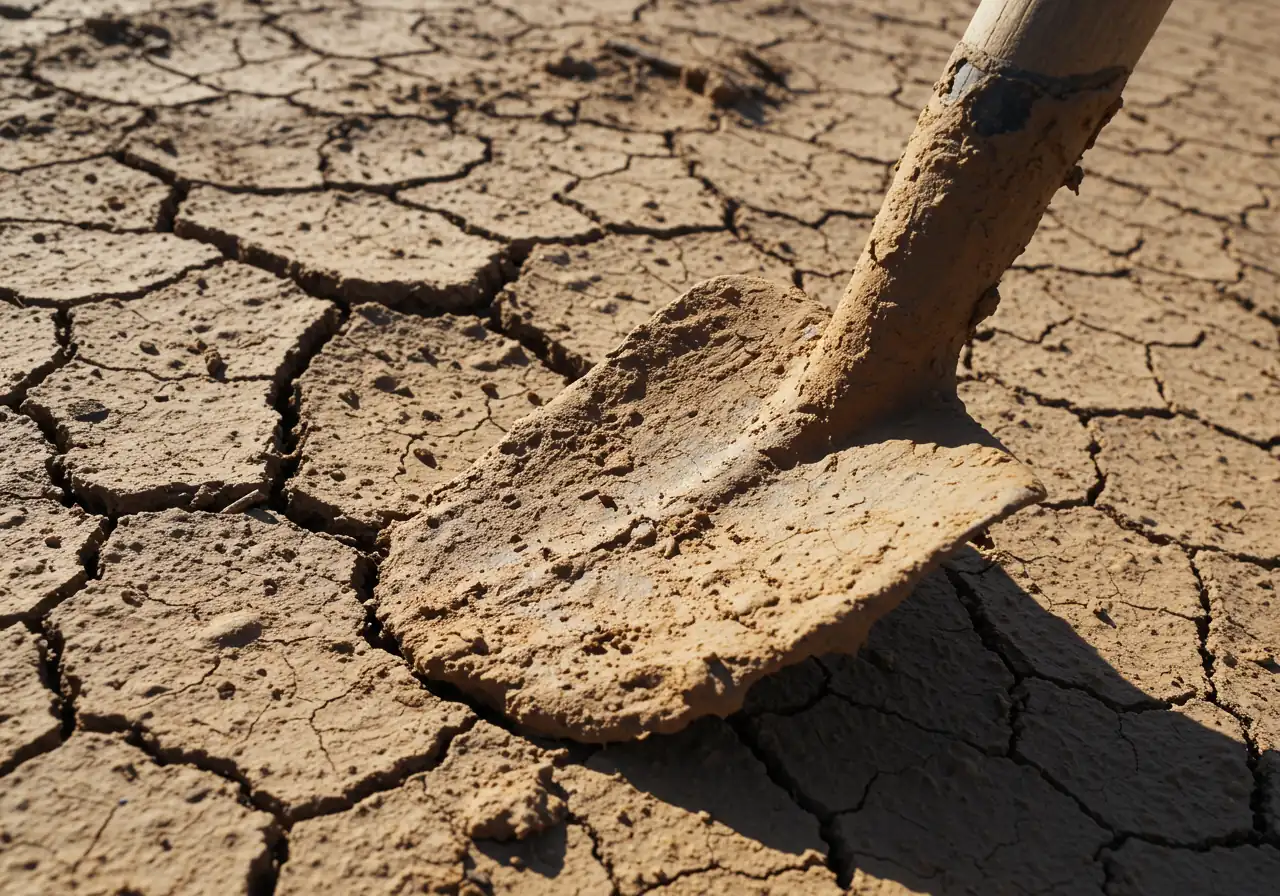
So, what exactly *is* this stuff we wrestle with? Think of soil as being made up of tiny rock particles. Sandy soil has big particles, like beach sand. Clay soil, on the other hand, is made of super-fine particles, packed incredibly close together. Imagine tiny, tiny plates stacked tightly – that's kind of like clay.
The Sticky Situation: Why Clay Can Be a Challenge
Now, this tightly packed structure brings a few challenges to our gardening adventures:
- Compaction City: Because those tiny particles squish together so easily (especially when wet, or if walked on a lot), clay soil gets compacted *fast*. This makes it tough for air and water to move through, and even tougher for plant roots to push their way down. Remember that root crowding we talked about earlier? Compacted clay makes it even harder for roots to find space.
- Drainage Drama: When it rains heavily, water struggles to drain through dense clay. It can sit on the surface or just below, creating soggy conditions. This "bathtub effect" can drown plant roots, leading to root rot and unhappy plants. Poor drainage can also create the perfect environment for controlling common lawn weeds in challenging soil, as some weeds don't mind wet feet as much as your grass does.
- Hard Work Handling: Clay soil has a split personality. When it's dry, it can bake hard like concrete. When it's wet, it becomes heavy, sticky muck that clings to your boots and tools like superglue. Finding that "just right" moisture level to dig or plant can feel like a guessing game. This makes tasks like digging holes a real workout, especially if you're thinking about adding larger plants; having some essential tree planting tips for Ottawa's heavy soil can make a big difference.
But Wait, There's an Upside! (Seriously!)
It's not all doom and gloom! Clay soil actually has a superpower:
- Nutrient Hoarding: Those tiny, tightly packed particles are fantastic at holding onto nutrients and water (when it eventually gets in). Unlike sandy soil where nutrients wash away quickly, clay soil holds onto the good stuff, making it potentially very fertile *if* we can improve its structure. Healthy plants growing in nutrient-rich soil are often more resilient, which is why regular care like keeping your shrubs healthy with summer pruning techniques is still important.
Know Your Soil: The Super-Simple Jar Test
Want to see how much clay you're *really* dealing with? Try this easy test:
- Dig down a few inches (avoid the very top layer) and grab a sample of your soil, enough to fill about one-third of a straight-sided glass jar (like a mason jar). Remove any big rocks or roots.
- Fill the jar about two-thirds full with water. Add a teaspoon of dish soap (this helps separate the particles).
- Screw the lid on tight and shake that jar like crazy for a couple of minutes until the soil clumps break apart.
- Set the jar somewhere it won't be disturbed and watch. The heavier particles (sand) will settle first, often within a minute. Silt will settle next, taking a few hours. The finest clay particles might take a day or two to settle completely, leaving the water on top clearer (or maybe still a bit cloudy).
- You'll see distinct layers: Sand at the bottom, silt in the middle, and clay on top. The thickest layer tells you your dominant soil type. If that top clay layer is significant (say, more than 30-40%), welcome to the Ottawa clay club!
Understanding your soil is the first crucial step. Knowing you have clay helps you make smarter choices, whether it's amending the soil with organic matter (like compost!), choosing plants that tolerate clay better, or incorporating raised beds into your plans. It’s all part of creating smart landscape design ideas for tricky Ottawa yards. While working with clay takes effort, it's definitely achievable. And if tackling heavy soil improvements feels overwhelming, remember there are always professionals who can help; check out our comprehensive landscaping services for options. Getting your boots dirty is part of the fun, but knowing *what* you're digging into makes all the difference!
The Underground Scuffle: Why Plant Roots Go to War
Okay, let's dive deeper into that hidden battleground beneath our feet. We know Ottawa's clay soil can be a bit clingy, but *why* exactly do plant roots end up duking it out like wrestlers fighting for the last donut? It's not like they *want* to cause trouble, but sometimes, we gardeners accidentally set the stage for an underground scuffle.
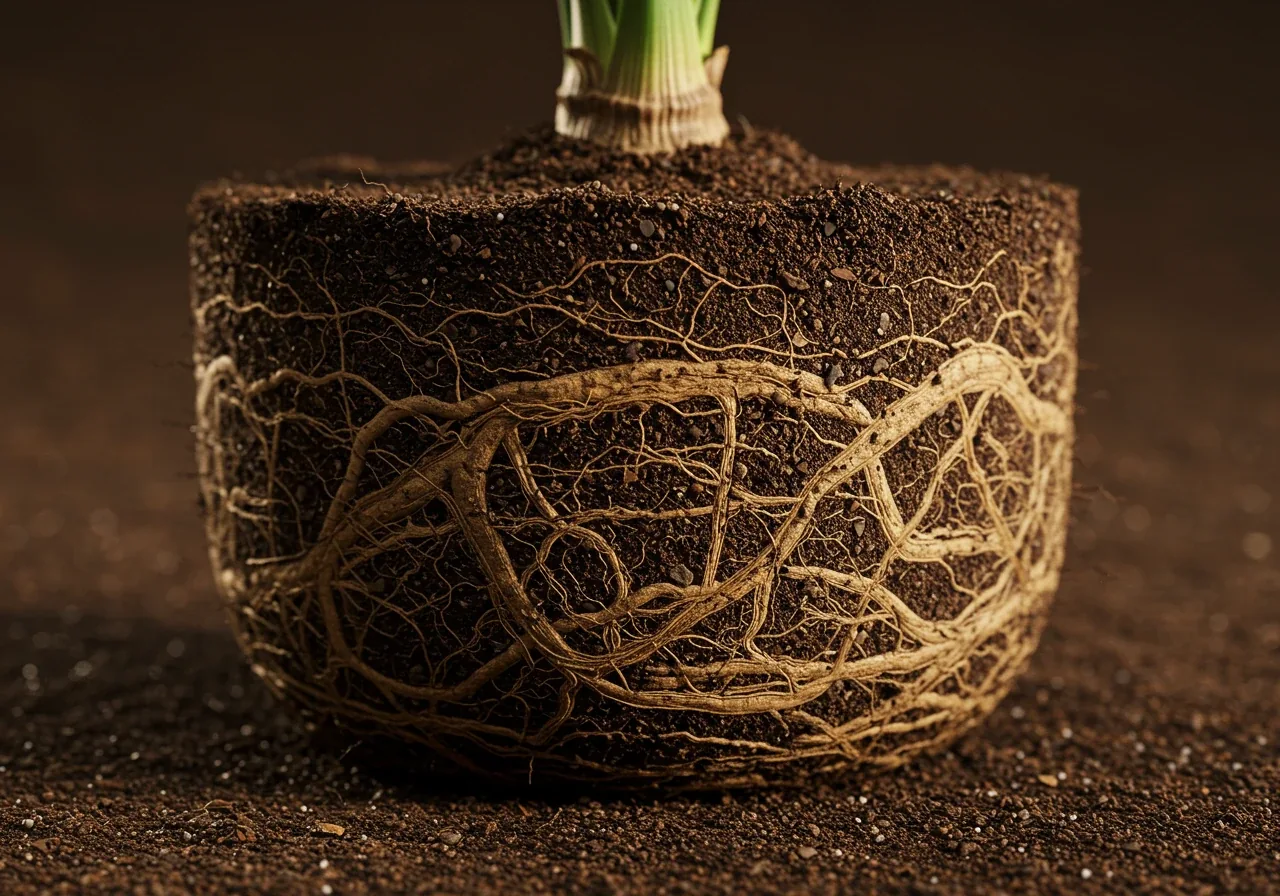
Think of it this way: roots need three main things – water, nutrients, and space to breathe (yes, roots need oxygen too!). When too many roots are crammed into one spot, it becomes a frantic competition for these limited resources. Here are the main culprits behind this subterranean turf war, often made worse by our dense soil:
- Planting Pals Packed Too Tightly: This is probably the most common reason for root wars. We see a tiny plant in a nursery pot and think, "Oh, it's so small!" We forget that cute little perennial or shrub has big dreams... and potentially *big* roots! When we plant things too close together, their roots inevitably crash into each other as they grow, fighting for the same patch of soil. In our lovely clay soil, roots often spread out horizontally more than digging deep (because pushing through dense clay is hard work!), making this side-by-side crowding even worse. Actionable Tip: Always check the plant tag for its *mature* size and recommended spacing – give 'em elbow room from the start! Ignoring this is like inviting fifty people to a party meant for ten; things get uncomfortable fast. Sometimes, untangling this kind of mess requires significant garden intervention, where an expert Ottawa garden clean up service can help sort things out and give remaining plants a fresh start.
- The Wrong Plant in the Wrong Place (Square Peg, Round Hole): Ever tried fitting a giant sofa into a tiny studio apartment? Same idea here in the garden. Planting a tree species known for a massive, spreading root system (like some maples or willows) right next to your driveway, patio, or worse, your house foundation, is asking for future headaches. Those roots are genetically programmed to grow and seek resources, and they won't necessarily stop just because there's concrete or brick in the way. This is a particular concern for homeowners in established Ottawa neighbourhoods like Manotick, where beautiful, mature trees might be getting a bit too cozy with house foundations over decades. Similarly, planting sun-loving prairie grasses that naturally want deep roots right next to shallow-rooted, moisture-loving flowers in heavy clay creates conflicting needs in a small space. Actionable Tip: Do a little research! Choose plants whose mature size and root habits are appropriate for the *specific* spot and its conditions. This is key to long-term landscaping harmony. You can find more inspiration and tips on our Google My Business page.
- The Big Squeeze: Soil Compaction Strikes Again: As we touched on earlier, clay soil loves to get compacted. Foot traffic (even from pets!), heavy wheelbarrows or mowers, even working the soil when it's too wet can squish those fine clay particles together like sardines in a can. Compacted soil leaves very few easy channels for roots to grow through. So, instead of spreading out nicely, roots are forced to follow the path of least resistance, often crowding into the same few available cracks and looser pockets of soil. This concentrates the roots and intensifies the competition immensely. It can even make your lawn struggle, as compacted soil prevents grass roots from getting the air and water they need. Sometimes, the best fix for a chronically compacted lawn area involves starting over with professional sod installation on properly prepared, loosened soil. Actionable Tip: Try to avoid walking directly on garden beds whenever possible. Use paths or stepping stones. Aerating compacted lawn areas can also make a big difference for grass roots.
Foundation Frustrations in Manotick (and beyond!):
That point about roots near foundations deserves extra attention. While the delicate roots of small flowers usually aren't an issue, the powerful roots of large trees or shrubs constantly seeking water can potentially exploit tiny, *existing* cracks in foundations, gradually making them worse over time. They don't usually *cause* the initial crack, but they are opportunistic explorers! Proper plant selection and, crucially, planting large species a safe distance *away* from foundations are vital preventive landscaping measures.
Challenges of Ottawa Clay Soil
- Compaction: Easily squished, reducing air/water flow.
- Poor Drainage: Water sits, potentially drowning roots.
- Difficult to Work: Concrete-like when dry, sticky mud when wet.
- Slow Warming: Stays cooler longer in spring.
Despite challenges, clay holds nutrients well when properly managed.
Main Causes of Root Crowding
- Planting Too Close: Most common cause; ignoring mature plant size.
- Wrong Plant Choice: Aggressive roots near structures or unsuitable species for the spot.
- Soil Compaction: Forces roots into limited channels, increasing competition.
- Lack of Soil Preparation: Roots struggle to penetrate dense, unamended clay.
Addressing these causes proactively prevents future root wars.
Key Solutions for Root Harmony
- Proper Spacing: Give plants room based on mature size.
- Soil Amendment: Regularly add compost/organic matter.
- Correct Planting Depth: Keep root flare above soil level.
- Mulching: Conserves moisture, suppresses weeds, moderates temperature.
- Wise Watering: Deep and infrequent watering encourages deeper roots.
- Right Plant, Right Place: Choose species suited for clay and the location.
Need help implementing these? Consider our full range of services.
Dealing with established root crowding can be tricky. It might involve carefully digging up and dividing overgrown perennials in the spring or fall, relocating shrubs (which can be stressful for the plant and heavy work for you!), or sometimes making the tough decision to remove a plant that's causing too many problems. If your yard feels generally overrun and tangled from years of unchecked growth leading to these underground battles, calling in a professional Richmond yard cleanup service if you're in that area, or a broader city-wide yard cleanup service, can provide a much-needed reset. Tackling these underground battles is just one part of creating and maintaining a thriving landscape; remember that help is available through comprehensive landscaping services if the root wars in your yard feel too big to handle alone. Giving your plant roots the space and conditions they need to thrive peacefully is the secret to happier, healthier, and more beautiful plants above ground!
Strategic Planting for Peace: Choosing and Spacing Plants Wisely in Ottawa
Okay, team, let's talk strategy! We've discussed the underground root battles and Ottawa's clingy clay soil. Now, how do we plant smart to keep the peace and create a thriving garden landscape? It's all about choosing the right plants and giving them the personal space they deserve – think of it as good garden etiquette! Ignoring this step is like inviting way too many people to a potluck in a tiny kitchen; things get crowded and messy fast.
Choosing Your Garden Gladiators (Wisely!)
Not all plants are created equal, especially when facing our local conditions. Here’s what to keep in mind when selecting recruits for your garden army:
- Know Your Zone: Ottawa is generally in Plant Hardiness Zone 5a or 5b. This means choosing plants *rated* for Zone 5 or lower (like Zone 4 or 3) is crucial. These tough cookies can handle our chilly winters without needing excessive babying.
- Clay Crusaders: Some plants just shrug off clay soil better than others. Look for descriptions like "adaptable to various soils," "tolerates clay," or "prefers moist soil". Don't try to force a plant that desperately needs sandy, well-drained soil into heavy clay. Check resources like the City of Ottawa Tree Planting guidelines for suitable local species.
- Size Matters (A Lot!): This is HUGE. That adorable little shrub in the pot? It wants to grow up! *Always* check the plant tag or description for its *mature* height and spread. Planting based on its current size is a guaranteed path to future overcrowding. You might end up needing a major intervention down the road, something like a full professional Ottawa yard cleanup service to untangle the mess.
Give 'Em Room to Breathe: The Spacing Game
Once you've picked your players, spacing them correctly is key. Think long-term!
- Follow the Tag: Use the mature spread information! If a shrub grows 5 feet wide, plant its center at least 2.5 to 3 feet away from the center of its neighbour.
- Air Flow is Your Friend: Proper spacing allows good air circulation, reducing fungal disease risk, especially in humid Ottawa summers.
- Consider the Roots (Again!): Space plants with vigorous or spreading roots even further apart, especially from foundations, walkways, or septic systems (a consideration in areas like Osgoode or Metcalfe needing services like Metcalf Property Cleanup).
Plant Picks for Ottawa Peacekeeping (Examples):
Here are a few reliable choices known to handle Ottawa conditions, including clay (though amending the soil always helps!):
- Trees: Serviceberry (Amelanchier), Freeman Maple (Acer x freemanii - needs space!), Hawthorn (Crataegus).
- Shrubs: Potentilla, various Dogwood species (Cornus), Spirea varieties.
- Perennials: Daylilies (Hemerocallis), Hostas (shade), Coneflower (Echinacea - sun), Sedum (Autumn Joy).
Roots: Friend or Foe? A Quick Comparison Idea
Knowing root behavior helps placement:
| Root Behavior | Examples | Placement Considerations |
|---|---|---|
| Well-Behaved | Serviceberry, Many Crabapples, Potentilla, Hostas, Daylilies, Most Ornamental Grasses | Generally safer near structures or in tighter spots. |
| Aggressive/Spreading | Norway/Silver Maple, Willows, Poplars, Sumac, Ribbon Grass | Needs *lots* of space. Plant far from foundations, pipes, property lines. Better for larger properties, perhaps requiring prep like a Marionville property cleanup service. |
Putting it All Together
Strategic planting is about thoughtful planning. Choose appropriate plants and give them space to prevent root wars and create a healthier garden. Planning makes the actual planting smoother. If you need help, exploring options for professional expert garden installation ensures the best start. This planning also applies to lawns; understanding quality sod installation is helpful.
If you ever need advice, don't hesitate to reach out. Your information is handled responsibly per our company privacy policy. Happy planting!
Preparing the Groundwork: Soil Amendment and Smart Planting Techniques
Okay, let's get down to the nitty-gritty – actually preparing the soil and getting those plants settled! We know Ottawa's clay can be stubborn, but with compost and digging, we can make it welcoming for roots. This stage is like rolling out the welcome mat!
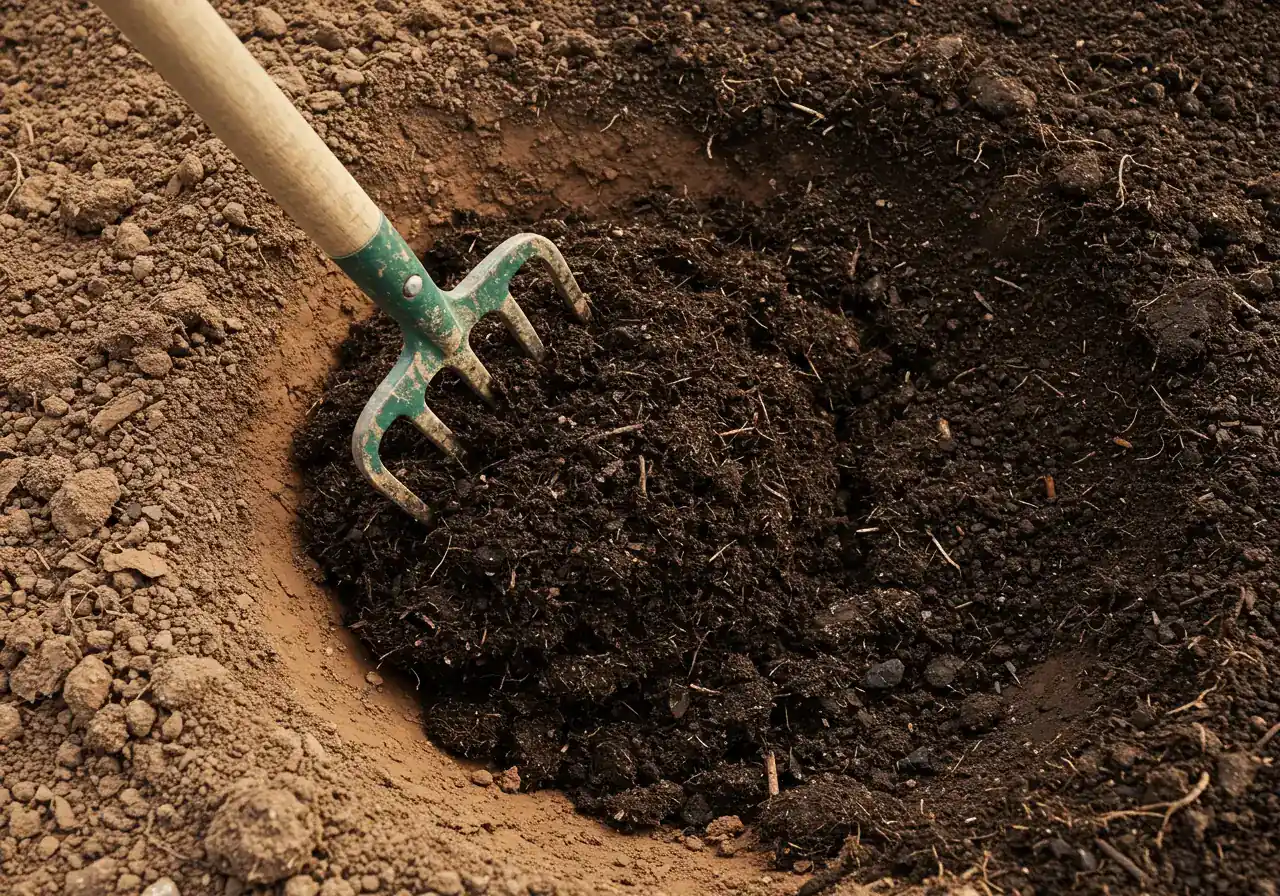
Giving Your Soil a Makeover: The Magic of Amendment
Planting directly into heavy clay is tough. Amending means adding materials to improve structure. For clay, we want to break up density, improve drainage, increase aeration, and make it easier for roots. The superhero? *Organic matter* (compost, aged manure, leaf mold).
- It breaks up clay particles.
- It helps retain moisture *and* drain excess water.
- It slowly releases nutrients.
What Kind of Good Stuff Should You Add?
- Compost: Gold standard! Homemade, bagged, or municipal.
- Leaf Mold: Excellent for structure, lower in nutrients. Great use for fall leaves.
- Well-Rotted Manure: Ensure it's aged (dark, crumbly, no strong ammonia smell).
- Note on Peat Moss: Environmental concerns exist; compost/leaf mold are more sustainable.
Conceptual Impact of Soil Amendment on Clay
*Conceptual representation. Actual improvement varies.
How to Do It Right:
- Go Broad: Spread 2-4 inches of organic matter over the *entire* garden bed.
- Mix It In: Work it into the top 6-12 inches of soil. Yes, it's work, but crucial! This is key after clearing, a task an expert Ottawa property cleanup service might do. For ongoing care, services like a garden clean up service in Marionville can incorporate amendment.
- Repeat Annually: Top-dress beds with compost each year to maintain good structure. Good soil preparation is key.
Planting Like a Pro: Setting Your Plants Up for Success
Alright, the soil's better! Now, let's plant correctly to help plants establish quickly.
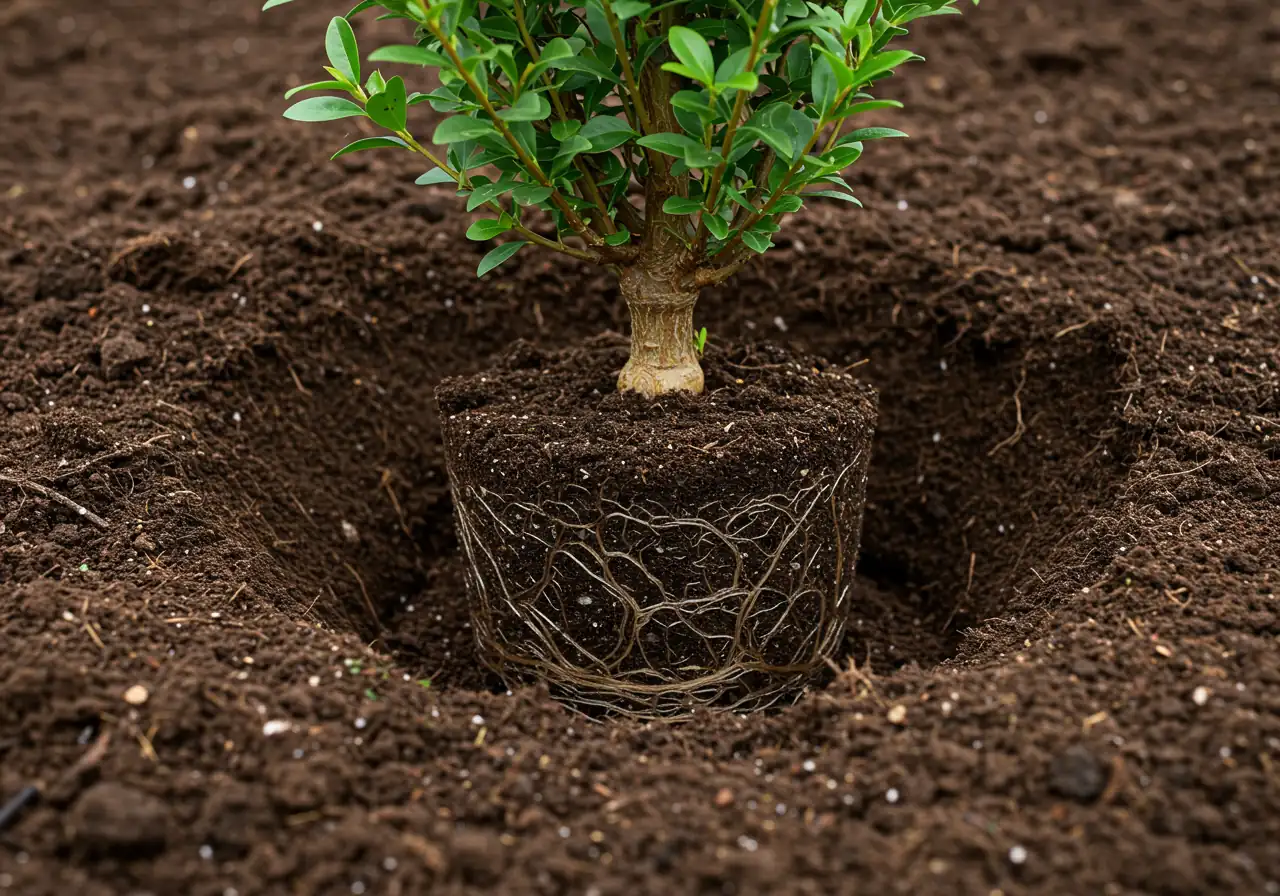
Step-by-Step Planting Guide (How-To):
- Gather Your Gear: Plant, shovel, amended soil, water, mulch.
- Dig the Hole: Same depth as root ball, 2-3x wider. Roughen smooth sides.
- Check the Roots: Gently tease apart circling roots. Make vertical cuts if severely pot-bound.
- Mind the Depth! Critical: Place plant so top of root ball is level with or *slightly higher* than surrounding soil. Root flare (where trunk widens) must be visible above soil for trees/shrubs.
- Backfill Gently: Use amended soil. Firm gently, don't stomp! Avoid compaction.
- Water Well: Water thoroughly to settle soil. Let soak, water again.
- Mulch Magic: Apply 2-3 inches organic mulch, keeping 1-2 inches away from stem/trunk. Helps moisture retention and weed control, key parts of garden maintenance.
Following these steps gives plants the best start. It's more effort upfront, but leads to healthier growth. Preparing large areas can be tough. If you're planning a big overhaul, consider a professional garden installation. We value client input, so feel free to provide feedback on our estimates. We aim for results that make us proud to say thank you for your trust!
Keeping the Peace: Long-Term Care for Happy Roots in Clay
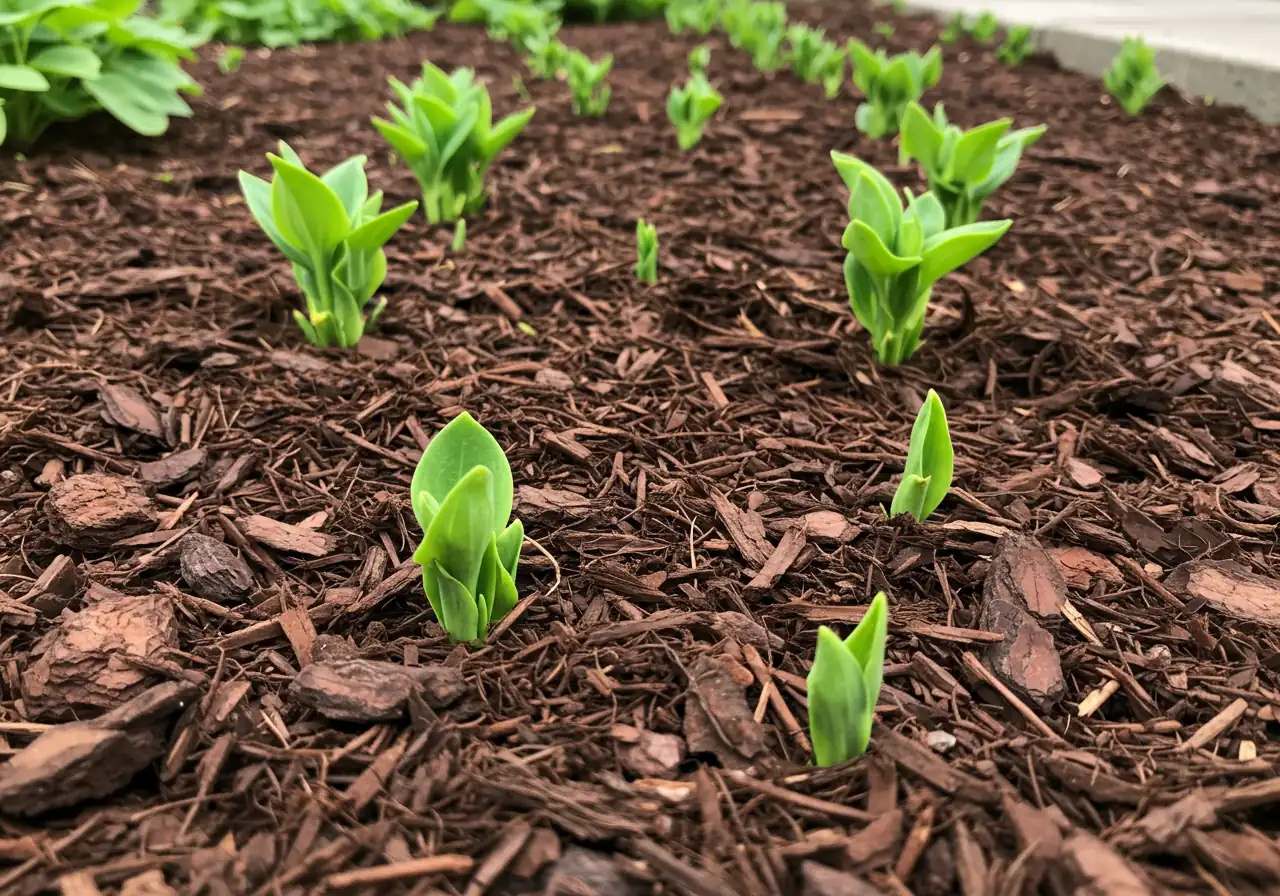
Alright, garden peacekeepers! You've prepped the soil and planted wisely. High five! But keeping the peace underground requires ongoing attention, like diplomacy for your dirt. Long-term care is crucial, especially in our challenging clay.
Watering Wisely: The Deep Drink Approach
- Deep and Infrequent is Best: Water deeply when soil starts drying (check 2 inches down). Encourages deeper roots. Forget light daily sprinkles.
- Slow and Steady Wins the Race: Apply water slowly (drip/soaker hose ideal) so it soaks in, doesn't run off. Water early morning.
- Watch for Signals: Wilting = thirsty (usually). Yellowing/soggy soil = too much water (risk in clay!). Adjust based on plant needs and weather. Need help with regular watering or other tasks? Check out city garden maintenance services.
Mulching Matters: The Protective Blanket
Maintaining a 2-3 inch layer of organic mulch (shredded bark, wood chips) is key:
- Conserves moisture.
- Suppresses weeds.
- Moderates soil temperature.
- Improves soil slowly as it breaks down, continuing the work of initial soil preparation.
- How-To: Top up mulch each spring. *Crucially*, keep mulch 1-2 inches away from plant bases/trunks to prevent rot. Learn more about mulching and edging.
Seasonal Check-Ins: Your Yearly Garden Calendar
Spring (April-May)
Clean up debris, prune dead branches, check/top-up mulch. Apply fresh compost for a nutrient boost. Prepare for the growing season, similar to a spring city garden clean up.
Summer (June-August)
Monitor watering, especially during dry spells. Weed regularly. Watch for pests/diseases. Enjoy the blooms!
Fall (September-November)
Cut back dead perennials (or leave for winter interest). Rake leaves (compost!). Plant spring bulbs. Deep water evergreens before freeze. A thorough fall tidy, like a Marionville garden clean up service provides, prevents overwintering issues. Consider a full Marionville yard cleanup for overall health.
Winter (December-March)
Protect sensitive shrubs (burlap wraps). Avoid walking on frozen beds. Plan for next year! Get expert advice from resources like the Master Gardeners of Ottawa-Carleton.
Recognizing Distress Signals: When Roots Cry Foul
Keep an eye out for:
- Wilting (even with moist soil - could be rot).
- Yellowing Leaves (Chlorosis - nutrient or water issues).
- Stunted Growth.
- Branch Dieback.
- Premature Fall Colour or Leaf Drop.
If you see these, investigate the cause (water, compaction, damage). Addressing the root cause (pun intended!) is key. For help diagnosing widespread issues, consider a property clean up assessment.
A Note on Root Barriers:
In specific cases (near pipes/foundations), physical root barriers installed *before* planting might be used to guide roots. They require proper installation and aren't foolproof. Generally a specialized solution.
Keeping the Harmony
Long-term garden peace relies on consistent care: watering, mulching, seasonal attention. Setting up a plan, whether DIY or professional, requires understanding the scope; check service terms and conditions if using professionals. If facing persistent issues or feeling overwhelmed, seek advice. Feel free to contact us for personalized advice tailored to your Ottawa garden. For conservation insights related to soil and water, check the Rideau Valley Conservation Authority. Keep up the good work!
Highlight Box: Quick Tips for Root Harmony
Dealing with Ottawa's charmingly stubborn clay soil? Keep the peace down below with these handy tips:
- Give 'Em Elbow Room: Check mature plant size *before* planting! Proper spacing prevents future turf wars. Smart landscaping material selection includes choosing the right size plant.
- Befriend Compost (Lots of It!): Mix generous amounts of organic matter into the *entire* bed before planting to improve drainage and root exploration. Excellent soil preparation is foundational.
- Plant High, Not Shy: Ensure the top of the root ball is level with or slightly *higher* than surrounding soil. Crucial for trees/shrubs.
- Mulch is Your Mate: A 2-3 inch layer conserves moisture, suppresses weeds, and reduces compaction. Keep it away from stems! Proper mulching and edging techniques help.
- Water Deeply, Less Often: Encourage deep roots. Soak well when the top inch or two is dry. Complements effective lawn care strategies.
- Think Ahead (or Correct Course): Plan for the future. If roots are already tangled, consider dividing perennials or relocating shrubs. Prevents need for major garden transformations later.
FAQs: Your Ottawa Clay Soil & Root Questions Answered
Ah, the classic Ottawa clay conundrum! The single best thing you can do is consistently add organic matter. Think compost, aged manure, or leaf mold. Don't just add it once; make it an annual habit. Spread a few inches over your garden beds each year and gently work it into the top layer, or just let worms pull it down. This gradually improves soil structure, making it less prone to cracking hard or turning into goo. It’s like giving your soil a spa day, improving drainage *and* moisture retention over time.
It's tougher once plants are established, like trying to un-bake a cake, but not impossible! Depending on the shrubs and how crowded they are, you might carefully dig up and relocate one or more during the dormant season (early spring or late fall). Another option is selective pruning – sometimes removing a whole competing shrub gives the others breathing room. For badly overgrown areas, it might require significant work. You can learn more about the teams who tackle these challenges by checking out our company history and values.
Absolutely! Raised beds are a fantastic workaround for heavy clay soil, popular from Barrhaven to Greely. You get to control the soil mix completely, ensuring excellent drainage and a root-friendly environment from day one. You can fill them with a high-quality loam and compost mix. Just remember, they tend to dry out faster than in-ground beds, so keep an eye on watering. Plus, they can add great structure and visual interest to your landscaping design!
Great question, especially important in areas like Manotick with beautiful homes! Avoid trees known for aggressive, water-seeking root systems near foundations. Big offenders include Willows, Poplars (including Aspens), Silver Maples, and sometimes Norway Maples. While they don't *usually* crack foundations themselves, their roots can exploit existing tiny cracks searching for moisture, making problems worse over time. Always research a tree's mature size *and* root habits before planting it close to any structure.
We really recommend amending the *entire* bed. Just amending the planting hole creates a 'bucket effect' in clay soil. Water fills the lovely amended spot but struggles to drain out into the surrounding dense clay, potentially drowning the roots. Improving the whole area encourages roots to spread outwards naturally into better soil, leading to healthier, more stable plants. Think broader benefit, not just the immediate planting spot. Keeping the whole bed healthy includes good edging, which you can learn more about with tips on proper mulching and edging practices.
Yes, definitely! Stressed plants aren't always thirsty. In heavy clay soil like we often see in Greely or Osgoode, roots can struggle even if the soil is moist. Poor drainage can lead to root rot (roots drowning!), while compaction prevents roots from accessing oxygen and nutrients. Crowded roots competing underground can also cause stress symptoms like yellowing leaves or wilting. Consistent care can help prevent this; consider if a regular plan like a dependable city garden maintenance service could help keep your soil and plants healthy long-term. For significant clearing needed before replanting, a service like our Metcalf area yard cleanup experts or Metcalf Garden Cleanup team could prepare the space properly. Check out options like City Property Cleanup for larger scale needs.
Conclusion: Cultivating a Peaceful Underground in Your Ottawa Landscape
Whew! We've dug deep into the world beneath your garden beds, tackling Ottawa's tricky clay and the underground wrestling matches plant roots can get into. It might seem like a lot, but remember, creating a peaceful underground landscape boils down to a few key things: giving your plants enough elbow room from the start, consistently improving your soil with glorious organic matter (hello, compost!), watering deeply but less often, and using a cozy mulch blanket.
Taking these steps isn't just about avoiding future headaches; it's about fostering truly healthy, vibrant, and resilient plants. Happy roots mean gorgeous blooms, lush foliage, and a garden that brings you joy, not frustration. You've got this! Think of yourself as the chief diplomat for your dirt – keeping the peace treaty signed and sealed.
- Ready to tackle your specific root woes but want a guiding hand? If your garden in Richmond or elsewhere (like needing Ottawa Property Cleanup Service or Metcalf Property Cleanup Service) needs a personalized peace plan, reach out to us for a friendly consultation!
- We'd love to see your garden successes! Share photos of your thriving plants or ask questions – let's build a community of happy Ottawa gardeners!

